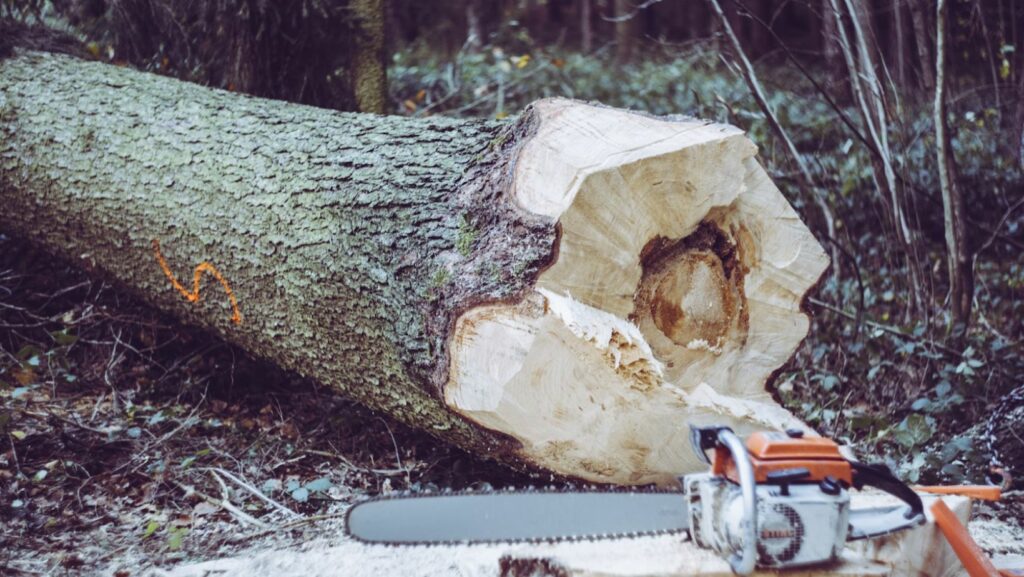Have you decided to remove the tall oak standing in your backyard?
Tree removal seems straightforward for homeowners until they examine all the necessary details. Tree removal expenses show significant fluctuations with small garden trees costing a few hundred pounds while massive trees near power lines come with several thousand pounds price tags.
Knowing tree felling costs ahead saves homeowners from serious trouble and financial loss later.
What you’ll discover:
- Understanding Tree Removal Pricing Basics
- The Height of Trees Directly Impacts Your Felling Bill
- Location Complications That Drive Up Costs
- Professional vs DIY: The Real Cost Breakdown
- Smart Budgeting Strategies for Tree Work
Understanding Tree Removal Pricing Basics
Tree felling costs result from specific calculations based on numerous factors. Homeowners who learn about the multiple factors arborists evaluate for pricing can budget tree removal services more efficiently.
Each tree removal job presents its own set of characteristics which leads to these price range variations. The removal costs for two trees that appear identical can differ significantly depending on their health status and surrounding environment accessibility.
Professional tree surgeons provide accurate removal estimates by examining the tree species, its physical state, closeness to buildings and adherence to local rules. Getting a proper tree felling quotation requires an on-site assessment rather than phone estimates.
The key cost drivers include:
Tree size and height matter enormously. When trees reach large sizes they need specialized tools while also demanding extended time and increased safety measures. The ease of reaching a tree site determines how crews manage equipment transportation and debris removal. The health of trees determines removal challenges since diseased or dead trees create hazardous conditions for felling operations.
Across the UK tree surgeons charge an average hourly rate of £25 to £35 although specialist professionals demand higher fees for complicated work.
Size Matters: How Tree Height Affects Your Bill
The height of a tree stands as the most significant determinant of removal costs because the price increases occur in a non-linear manner.
Removing trees shorter than 25 feet requires spending between £150 and £350. Basic equipment enables small crews to complete these projects in a short time.
Removal costs for trees between 25 and 50 feet tall fall within the £350 to £650 range. Medium-sized tree removals demand both more sophisticated machinery and extended work schedules.
Safely removing large trees with heights between 50 and 75 feet costs between £650 and £1,200. The operation of specialized tools like bucket trucks and cranes demands experienced crews who possess knowledge of complex rigging techniques.
When trees exceed a height of 75 feet they result in increased premium pricing categories. The removal costs for exceptional tree specimens can exceed £1,500 while potentially rising above £3,000. These projects need implementation over multiple days with crane assistance and detailed safety planning.
But height isn’t everything…
Both tree diameter and height equally affect the complexity of removal operations. Shorter trees with wide spreading canopies need a more meticulous dismantling process. Dense branching patterns extend removal time and drive up labor expenses.
Crown shape influences removal strategy. Removing trees with multiple trunks or abnormal growth patterns requires specialized techniques which demand additional time and expertise.
Location Complications That Drive Up Costs
A tree’s placement holds equal importance to its actual dimensions.
Trees near structures require careful disassembly of each part rather than standard cutting methods. The need for safe branch lowering extends the duration of work projects. Utility companies must be involved in tree removal projects because power lines near trees present extra challenges.
Access limitations can double removal costs. Trees in fenced backyard corners or inaccessible areas mandate manual dismantling by workers because machinery cannot reach them. Debris transportation through narrow spaces done manually leads to higher labor hour totals.
Regional cost variations are substantial. Labor service costs vary by region since London and the Home Counties require higher fees compared to other UK locations. Urban areas experience higher cost rates due to greater overhead expenses and stricter regulatory requirements.
Soil conditions affect stump removal costs. Excavating rocky terrain and clay-based soil requires tougher machinery and extended excavation time. Root systems beneath driveways or foundations create significant challenges for extraction operations.
Property slopes along with terrain irregularities make equipment positioning complex. Steep slopes limit access to machinery and require alternative stump removal methods.
Permit requirements vary by location. Local councils require permit acquisition for tree removal in protected species habitats or conservation areas. Project budgets need to cover permit expenses along with anticipated processing delays.
Professional vs DIY: The Real Cost Breakdown
Homeowners face unexpected costs when they remove trees without professional help.
Professional removal includes comprehensive insurance coverage. Property owners maintain liability for injuries resulting from tree removal work because homeowner insurance policies typically exclude coverage for such tasks. Tree surgery professionals have insurance policies which protect against property damage and personal injury arising from their tree work.
Equipment rental costs accumulate quickly. Rental fees for chainsaws along with safety gear and rigging equipment plus debris removal services for the weekend total several hundred pounds. Professional tree removal teams manage and upkeep costly equipment which they use for their work.
Safety expertise cannot be rented. Tree removal workers encounter multiple dangers including falling branches and chainsaw accidents along with electrical hazards from power lines. Arborists complete extensive training programs and receive certification before beginning their careers.
Professional services include value-added benefits: The professional service providers offer cleanup operations along with debris removal and stump grinding services which include completion guarantees. Homeowners who seek professional help face unexpected financial strain.
Smart Budgeting Strategies for Tree Work
Tree removal planning demands strategic consideration of both timing and scope along with careful contractor selection.
Seasonal timing affects costs significantly. Tree removals during winter are cheaper because demand decreases but weather conditions can cause project delays. The busy months of spring and summer bring higher prices but allow for more reliable scheduling.
Multiple tree removals can reduce per-tree costs. Contractors provide discounted rates for bulk work because their equipment and crews are already operational. Assessments of properties enable the identification of trees that require removal in the future.
Scope creep drives budget overruns. Clear quotes should specify exactly what’s included: The scope of work should clearly outline services that include tree removal as well as stump grinding and debris cleanup followed by site restoration. The pricing for extra services needs to be disclosed separately to eliminate unexpected costs.
Contractor selection impacts both cost and quality. Low-cost estimates are typically indicative of contractors who use shortcuts or who employ staff lacking experience. Premium contractors provide dependable outcomes at high cost.
Getting Accurate Professional Quotes
Qualified professionals must perform on-site evaluations to create accurate quality quotes instead of relying on phone estimates.
Established contractors supply written estimates that include detailed cost breakdowns for labor, equipment usage, materials required and disposal fees. Fair pricing baselines become clear when established contractors provide several quotes.
Contractor credentials matter significantly. Legitimate operations can be identified through professional certifications paired with insurance documentation and local references. Realistic timelines are essential because quality work demands sufficient time for completion.
In emergency scenarios there is no room for delayed action even though timing cannot be adjusted. Stress and expenses decrease through careful contractor selection and seasonal timing optimization when planning occurs ahead of time.
The Bottom Line
Professional contractors systematically evaluate interconnected factors to determine tree felling costs. The price range for tree services is affected by the tree’s size, its location, access conditions and regional differences.
Homeowners who understand cost drivers do their research before getting quotes. Effective planning combined with careful contractor selection and realistic budgeting creates successful projects which improve property safety and value beyond simple cost reduction goals.

